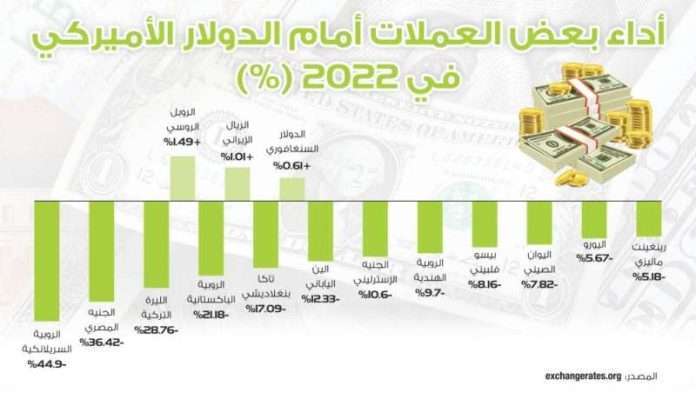The Japanese yen was the most affected, and the Swiss franc and the Canadian dollar were among the most resilient as many currencies witnessed a very volatile and difficult year in 2022, with the exception of the US dollar, which was a safe haven for investors and provided exceptional stability, after the vast majority of currencies around the world fell against the dollar over the past year.
According to the data, the past two years witnessed almost all major currencies recording losses against the dollar, and among those affected currencies was the single European currency, the euro, which fell for a short time below parity (meaning that the euro was less than one dollar) in September and October of 2008, before recovering by 5.3 percent in November 2022.
The Japanese yen was the main currency hit hardest, as its value fell by more than 25 percent since the beginning of 2021, and after reaching the lowest point this year in October, the yen broke through to its lowest level in 24 years, which led to the intervention of the Bank of Japan and pumped $ 42.8 billion to support the currency.
On the other hand, the Swiss franc and the Canadian dollar have been among the most flexible major currencies against the US dollar since 2021, as this is largely due to the financial and political stability of the two countries, in addition to Canada benefiting from higher crude oil prices in 2022, as it exported the majority of its crude oil through its southern borders to America.
The dominance of the dollar has many advantages over the United States, such as: increased treasury revenues from the currency held abroad, lower returns on government debt due to the lack of risk and liquidity premium, lower transaction costs due to small currency differences, and the market power of the US financial institutions that issue the currency. As well as being a strategic tool to be used in the pursuit of international geopolitical goals, it gives the United States a high degree of policy flexibility, particularly the freedom to pursue domestic policy objectives, a feature former French Finance Minister Valéry Giscard d’Estaing called an “exorbitant privilege.”
A variety of factors contributed to the strength of the dollar during 2022, as the rapid rise in interest rates by the Federal Reserve and the tightening of its balance sheet made the dollar a value-returning asset, and with the rise in interest, the returns of savings accounts and fixed-income securities such as US Treasury bonds, making it a more attractive alternative for investors.
At the same time, falling stock prices (particularly in the technology sector) further spurred investors to pull out of the risky and volatile equity markets and buy dollars.
Finally, compared to many other global economies, the prospects for the US economy remained flexible and with less risks, while Europe remained, on the other hand, facing an ongoing energy crisis due to the conflict between Russia and Ukraine, while China’s anti-Corona policies hindered the manufacturing sector in the country. as well as other industries.
The status of the US dollar as a safe haven during crises is a manifestation of its dominance in global financial markets, as about 50 percent of international trade takes place in dollars, and about half of all debt instruments and securities around the world are denominated in green currency, and in foreign exchange markets. The dollar is a party to about 90 percent of all transactions, while 60 percent of central bank reserves of foreign currencies are dollars in order to facilitate investments to conclude deals and pay international debt obligations, which makes the dollar the leading reserve currency in the world; Japan alone as the largest holder of US government debt, has more than $1.1 trillion, followed by China, which has about the same amount.
While the dollar rose for most of 2022, this trend is losing steam in the final months of the year. In September of 2022, the dollar index rose by 20 percent since the beginning of the year and reached its highest level at 114.8, but it has declined since then and gave up more than half of its gains until mid-December.
Investors around the world are watching closely to see if the dollar’s rise will continue to rise, or whether it will provide major currencies some relief in 2023. This outlook for the dollar depends on the US “Federal” reaction during the current year in terms of continuing to raise the price. Interest or its reversal, and this matter will completely affect the expectations of the appreciation of the dollar, while some experts believe that the trade-weighted dollar index will rise by 2 percent from its current levels until the end of the first quarter of 2023, before returning to decline by about 10 percent.
Factline
– 50 percent of international trade and debt instruments are in dollars
– 60 percent of the reserves of foreign central banks in US currency
– 90 percent of the world’s foreign exchange transactions are in dollars

















